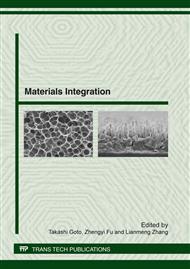p.3
p.7
p.11
p.17
p.21
p.27
p.32
p.38
p.42
Thermal Conductivity Design and Evaluation of Zirconium Phosphate Bonded Silicon Nitride Porous Ceramics
Abstract:
In this Paper, Five Fundamental Effective Thermal Conductivity Structural Models (Series, Parallel, Two Forms of Maxwell-Eucken and Effective Medium Theory) Were Used to Analyze and Design Silicon Nitride Porous Ceramics. Then α-Si3N4 Matrix Porous Ceramics Were Prepared with ZrP2O7 as a Binder and Thermal Conductivity of ZrP2O7 Bonded Si3N4 Porous Ceramic Was Evaluated. ZrP2O7 Bonded Si3N4 Porous Ceramic Had Open and Interconnected Pore Structure which is either in EMT or in Maxwell-Euken 2. The Thermal Conductivity of ZrP2O7 Bonded Si3N4 Porous Ceramics Changes from 2.0 to 0.5 W/m•K with Increasing the Porosity from 20% to 51%. The Obtained Results Showed that the External Porosity Material with Maxwell-Euken 2 Structure Had the Lowest Thermal Conductivity in All Porous Materials. The Open and Interconnected Pore Structure of ZrP2O7 Bonded Si3N4 Porous Ceramics Provided much Lower Thermal Conductivity.
Info:
Periodical:
Pages:
21-26
Citation:
Online since:
March 2012
Authors:
Price:
Сopyright:
© 2012 Trans Tech Publications Ltd. All Rights Reserved
Share:
Citation:


